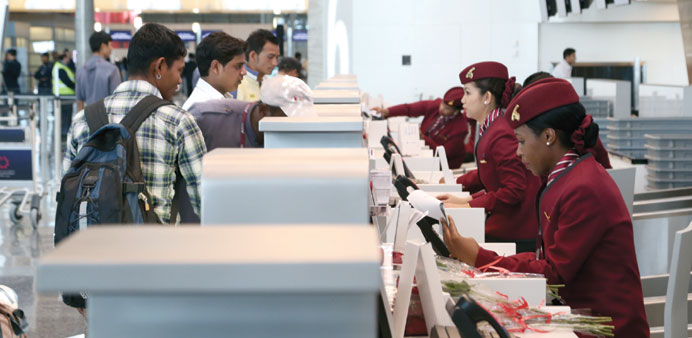Travellers are seen at a check-in counter at the Hamad International Airport. Plans are already being prepared to construct a second terminal at the recently-opened HIA, if passenger growth exceeds current projections, according to ICAEW.
Increasing intra-regional trade volume is central to reaching Qatar’s diversification objectives and could help assuage disruption caused by political turbulence in the Middle East, says a new report by ICAEW, a global organisation of chartered accountants.
In its latest quarterly ‘Economic Insight’ report, the body says Qatar’s economy is moving in the right direction, with the government investing in “transformative” transport and logistics networks to boost freight and passenger capacity.
According to the report, the GCC (Gulf Co-operation Council) nations are leading the region’s current rail and aviation investment boom as they race to encourage more cross-border trade and address increasing congestion issues in the face of rampant population growth and rapidly-developing tourism markets.
Saudi Arabia, Qatar and the UAE are leading the charge, with investment plans worth $45bn, $37bn and $22bn respectively.
The planned GCC Railway, a 2,177km project, which will link the networks of the six GCC countries, represents the most ambitious aspect of the region’s railway infrastructure plans. With the Middle East set to become one of the world’s most important aviation centres, expansion of airports in all the major GCC cities has also become a priority. Qatari plans are already being prepared to construct a second terminal at the recently-opened Hamad International Airport, if passenger growth exceeds current projections, the report said.
The GCC’s huge infrastructure pipeline is expected to see the transport and logistics sectors play an increasingly important role in the region’s economies. They should start to generate significant value from these assets in the form of efficient supply chains, delivery of goods and personnel across borders and supporting the activities of the travel and tourism industries.
Kuwait, Saudi Arabia, UAE and Oman will likely net the biggest windfalls, with logistics forecast to contribute 13.6%, 12.1%, 11.7% and 11.7% to their respective economies by 2018.
The contribution of Qatar’s logistics sector is also expected to grow, comprising 8.4% of real GDP (gross domestic product) by 2018, the report said.
The report shows that high investment levels in Qatar will support growth over the medium term, with real GDP expected to be 6.3% higher in 2014 and annual growth rising above 7% during 2015-16.
“While Qatar currently has the lowest level of intra-regional trade of all the GCC nations, exporting only 1% of total goods to the Middle East in 2013, this situation is expected to change significantly when the country’s rail and airport projects come online. This diversification will help foster internal commerce and investments necessary for sustainable long-term growth,” said Michael Armstrong FCA, ICAEW regional director Middle East, Africa and South Asia (MEASA).
While the GCC’s goods trade integration lags behind other regions in the world, free trade policies, continued minimisation of tariff and non-tariff barriers to trade and transport infrastructure will help foster deeper intra-regional trade links.
Currently, Qatar is the second most open trade market in the GCC scoring 80% on the Heritage Foundation’s Trade Freedom Index ahead of Oman, Bahrain, Kuwait and Saudi Arabia.
“With global oil prices forecast to fall over the medium-term, the need for economic diversification is becoming more pressing for the GCC countries. Qatar’s heavy investment in transport and logistics networks will pay off, drive growth and make a major contribution to diversifying the economy. However, more could be done to foster a competitive manufacturing sector that would reduce its dependency on hydrocarbon exports,” said Charles Davis, director, Centre for Economics and Business Research (CEBR).

